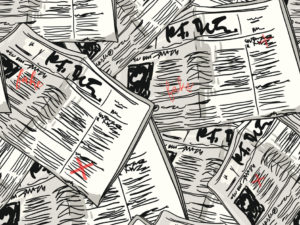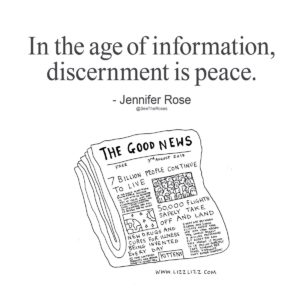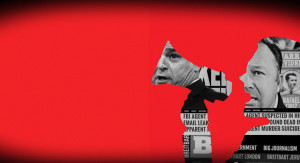Fake news
The Boise Weekly/ProPublica Illinois
May 4, 2018How Do You Identify Fake News?
Solid sources and some healthy skepticism can help.
By Vignesh Ramachandran, ProPublica
“Part of what we have to do ourselves is to create an internal speed bump, where we say, ‘Just wait a minute’ before you believe anything.”
[…]
‘Experts who study media and the rise of misinformation say you should approach all the news you read with a certain level of doubt, said Dan Gillmor, a professor at Arizona State University’s Walter Cronkite School of Journalism and Mass Communication. […] False news is also often twisted to present a story that triggers you emotionally, whether that’s anger or sadness, Silverman said. “If they can do that, then the chances of you reacting to it by liking it or retweeting it are much greater. So, you need what Silverman calls “emotional skepticism,” as well.’
Full article:
https://www.boiseweekly.com/boise/how-do-you-identify-fake-news/Content?oid=10427969
The core of journalism: betrayal.
April 9, 2018BuzzFeed
Ben Smith, BuzzFeed Editor-in-Chief
“This Is What It Was Like Learning To Report Before Fake News Was The Biggest Problem In The World
As a young reporter in Eastern Europe in 2001, I expected to witness the “end of history” and the flowering of democracy. That was just one of the mistakes I made.
—
I recognized myself in Suzy Hansen’s recent book on the delusions of our generation of Americans abroad, Notes on a Foreign Country.
“I would never have admitted it, or thought to say it, but looking back, I know that deep in my consciousness I thought that America was at the end of some evolutionary spectrum of civilization, and everyone else was trying to catch up,” she wrote.
[…]
There’s an axiom in reporting — crystallized by Janet Malcolm in The Journalist and the Murderer — that at the core of journalism is betrayal. I thought that’s what I’d done to Shydlovski. And I’ve thought a lot about the balance of responsibility to your sources and to your readers.
I had left Belarus on an overnight train the day after the election, and crossed the Ukrainian border on the morning of Sept. 11, as clear a day in that region as it was in New York. That afternoon, I sat in a Kiev newsroom watching my past assumptions about American power crumble, and walked outside to watch Ukrainians lining up at exchange bureaus to turn in their dollars. The story moved on.
[…]
Kozak, though, stuck around; he’s still working on the Lukashenko project from his desk in Foggy Bottom. And his own experience, he said, had taught him not to trust confident judgments about the future of an authoritarian.
“You get that blithe assumption that the status quo will always remain — or that this guy is so bad he’s got to go,” he said. “Neither are necessarily true, nor necessarily false.”
And Kozak is right: The main lesson I should have learned was about making predictions, about trusting the confidence of my American culture and of official sources on both sides, of imagining I knew more than I did. Even in the era of Steven Spielberg’s The Post and of a kind of glorification of the work of journalists, good reporting doesn’t offer easy lessons. It’s an uncertain business, and a necessarily anarchic one. Now I’m glad I wrote Shydlovski’s story, not despite the fact that I didn’t know where it would lead, but because of it.”
[full article]
Fact & Fiction
December 6, 2017Hannah Arendt (1906–1975) was one of the most influential political philosophers of the twentieth century. Born into a German-Jewish family, she was forced to leave Germany in 1933 and lived in Paris for the next eight years, working for a number of Jewish refugee organisations. In 1941 she immigrated to the United States and soon became part of a lively intellectual circle in New York. She held a number of academic positions at various American universities until her death in 1975.
[Standford Encyclopedia]
Blurring reality.
February 23, 2017
The term ‘Fake News’ blurs reality as language silos meaning and use. The question becomes, how do we communicate generally if terms and phrases hold different meaning depending on political perspective and ideology?
‘…the twitch was faked.’
January 18, 2017“How long is now?
Yes, that dog is moving, but not that tree. Plants don’t move.
Well, yes, they actually do. Trees grow and then they decay. It’s just that we can’t see it happening now. It happens over a longer span. Which means it is happening now, just not in a way that matches our frame.
Getting our time scale right is essential. It affects how we perceive the growth of our organization, or the changes in our planet. It changes the way we invest in education and how we react or respond to the news media.
Do we need a sweep second hand on our wrist watch or merely a page-a-day calendar to mark the passage of time?
Alan Burdick’s new book goes into the history of how we think about now (as compared to before and after) and one particular example stuck with me: What would happen if we were creatures that lived for only 28 days? Or for 300,000 days? And if our attention span compressed or expanded along with that outcome?
Often, people who are happier or more effective than we are are merely seeing things in a different (and more appropriate) time window.
And one last example, I’ll call it Dash’s Twitch: It turns out that the insanely stressful ticker that the New York Times had on their home page on election night, the one that kept flicking back and forth, taunting everyone who saw it, was actually using “real-time” data that only updated a few times a minute.
Which means that the twitch was faked. Yes, the data was moving over time, but it wasn’t moving now.
If our now gets short enough, everything is a twitch.
And twitches, while engaging, aren’t particularly useful or productive.”
-Seth Godin
[Anil Dash is the CEO of Fog Creek Software. He also founded Makerbase, Activate, and the non-profit Expert Labs, a research initiative backed by the MacArthur Foundation and the American Association for the Advancement of Science, which collaborated with the Obama White House and federal agencies.]
Fact from Fiction
January 5, 2017Higher Ed takes on Fake News Epidemic
Universities are working to tackle a digital age issue that’s making it more difficult to discern fact from fiction
Political transparency advocacy group VoteSmart has cataloged and published speeches, voting records, campaign financing and news coverage of more than 40,000 candidates for political office throughout the United States since 1992, and next month, will relocate to Drake University as its new national headquarters.
Officials say the relocation continues a tradition of partnership between VoteSmart and higher education, as the office has found permanent stations at schools like Oregon State University, the University of Arizona, the University of Southern California and the University of Texas at Austin. Throughout its history, they say, the organization has looked to higher ed as the lightning rod for change in political structure, social awareness, and today what some call a new threat to democracy: fake news.
The rise of fake news has become a wide topic of corporate and consumer culture over the last six months, peaking with the 2016 election and intense scrutiny of traditional and social media outlets and the impact of false stories which helped to drive false narratives about political candidates and events.
Facebook, the world’s largest social media platform, this week announced steps to limit the sharing and publishing of fake news on its site, which estimates suggest reaches 170 million North Americans daily. VoteSmart officials say colleges and universities are central to challenging news organizations and social platforms to stem the effects of fake news, which is part of the historic role of social change and information awareness that has spurred student movements for generations.
At the University of Maryland, journalism faculty remains in regular conversation about teaching quality industry practices, while giving students the full scope of their responsibility to provide accuracy and timeliness.
“We’re teaching students that they are going to have a tougher time with readers just assuming that they are credible,” says Lucy A. Dalglish, dean of UMD’s Philip Merrill College of Journalism. “Now more than ever before. you have less leeway to make mistakes.”
She says that the university has developed media literacy training for faculty and students with a specific portion of the course dedicated to discerning good and bad news sources. While Internet technology has made the job tougher for debunking bad news sources, she says the journalists can still do more to help the public understand why information is important, and how it is cultivated for reporting.
“We also need to teach them to stick up for themselves and for the industry they are going into. It’s also important to do a better job of explaining where we got information. Mention open records, public meeting acts so people know that the reporting is based upon something.”
The journalism school is also developing a pilot program for incoming students to learn better Internet search skills, and currently offers a mandatory skills source for freshmen and sophomores in conjunction with the school’s library to receive research insight from credentialed librarians.
“Younger people almost always take the more idealistic side of life, and have an enthusiasm for truth and accuracy,” says VoteSmart founding board member and senior consultant Adelaide Kimball. “They aren’t afraid to call out a lack of facts, and campuses have always been the appropriate places to do that.”
Kimball says that thousands of college students have helped to drive the VoteSmart agenda for decades, with its commitment to fact gathering and provision driving crossover appeal among students from a variety of college majors and career ambitions to volunteer as fact checkers and researchers. She says that any effort colleges and their students can make to reverse the effects of accepted misinformation preserves the integrity of journalism industry, and democracy at large.
“It’s becoming hard to convince people that they need the facts, that they need the truth,” says Kimball. “Somehow, we’ve got to get people to care, and to recognize what may not be accurate or fake and that they don’t accept it anyway.”
But what happens when caring turns to controversy on campus? From the 2015 Black on Campus Movement to this year’s student clashes on topics like academic freedom, free speech and white nationalism, some institutions are at odds on how to navigate areas of protest, information spreading and promotion, and social connotations carried by all areas of student mobilization.
Jennifer Glover Konfrst is an assistant professor and co-leader of Drake’s Strategic Political Communication program, and says that even in the classroom, curriculum and attitudes have shifted to analyze the effects of fake news on a public growing in its comfort with misinformation.
“In the past, we might have talked about the risks of being incorrect or sloppy in reporting, but you didn’t see it happening very often,” Konfrst says. “Now, we have the opportunity to show them this is what’s so harmful about fake news; it’s been shared 90,000 times and it’s not true, and it takes 13 hours for a story to be debunked on average online, and it’s all over the world.”
Faculty have been at the center of a specific news movement of their own in recent weeks, with the national college conservative advocacy organization Turning Point USA publishing a ‘Professor Watchlist,’designed to highlight professors whom it says are advancing liberal political agendas through teaching and in academic spaces. “TPUSA will continue to fight for free speech and the right for professors to say whatever they wish ; however students, parents, and alumni deserve to know the specific incidents and names of professors that advance a radical agenda in lecture halls,” according to a statement from its website.
The American Association of University Professors responded recently with a petition encouraging faculty members to submit their names to Turning Point USA for inclusion on the lists, suggesting that the tactics would not breed fear among the academic enterprise.
“The American Association of University Professors has supported academic freedom and opposed those who seek to curtail it for more than a hundred years, and will continue to do so, because the common good depends upon the free search for truth and its free exposition,” read a statement from the petition. “The type of monitoring of professors in which you are engaged can only inhibit the process through which higher learning occurs and knowledge is advanced.”
Konfrst, who was aware of the watchlist, says that she discloses her political affiliation at the beginning of her courses, and at their conclusion asks in her student evaluations of they felt all voices were afforded a chance to be heard.
“It’s hard, because you don’t want to have to feel like you have to prove your legitimacy to your students. I tell them that I’m going to allow all voices to be heard, I’m not going to tell you my political beliefs because it’s not about that. I put it out there that I have opinions, but I don’t think you’re going to notice them. Putting it out there is helpful, because there’s a difference in being unopinionated and being fair in your writing.”
Kimball says that collegiate response to fake news creation, ultimately, will prove to be a historic task for the sustainability of the public trust.
“We do see the advent of fake news as an enormous problem for democracy and our civic culture, she says. “I’m happy to hear that colleges are taking up this challenge immediately, because this is one of the most dangerous developments in our civic culture and probably hundreds of years, if not ever.”
“We seem to have gotten to a place, partly because of technology and people’s nature, that people have a hard time distinguishing what’s accurate and what’s not. If schools across the country can pound that into students and cover those important issues in a way that helps people to easily see what is accurate and what is not, it is a huge public service.”
Media in the age of Trump.
November 29, 2016‘You think the truth took a hit last year? It’s about to get worse. A lot worse.’
Welcome to the media in the Age of Trump.
- False rhetoric.
- False equivalency.
- Hyperbole.
- Ad hominum.
Charles Sykes/Politico Magazine
All of this was a long time coming.
[…]
Trump’s victory means that the most extreme and recklessly irresponsible voices on the right now feel emboldened and empowered. And more worrisome than that, they have an ally in the White House. The new media will not only provide propaganda cover for the administration, but also direct the fire of a loose confederation of conservative outlets against critics and dissenters.
[…]
So what is this brave new conservative media going to look like? Probably more like Alex Jones than National Review. The appointment of Breitbart’s Steve Bannon as chief adviser to the president-elect was the new regime’s implicit imprimatur on the new conservative media. But perhaps the most revealing moment was Trump’s reported call, on the Monday after the election, to Infowars’ Alex Jones to thank him for his support in the campaign.
Jones is not your garden-variety conspiracy theorist. He is a 9/11 truther, who believes the U.S. government conspired in the attacks to justify the creation of a police state. He has suggested that the government also may have been behind the bombings in Oklahoma City, which killed 168 people, and at the Boston Marathon, which killed three. And he has repeatedly suggested that the Sandy Hook shootings were a “hoax,” “synthetic” and “completely fake.” He also thinks the government wants to “encourage homosexuality so people don’t have children” and said that Hillary Clinton was “a frickin’ demon and she stinks and so does Obama.”
http://www.politico.com/magazine/story/2016/11/donald-trump-conservative-media-charlie-sykes-214483






